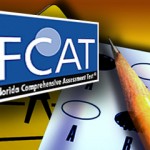Science Blogger Finds Problems With FCAT Questions
“The Happy Scientist,” blogger Robert Krampf, notes a number of problems with practice questions for Florida’s 5th and 8th grade FCAT science exams.
Among the issues are correct answers that rely on incorrect definitions, and answers test designers consider incorrect but actually are scientifically correct.
An example:
A glossary of definitions (Appendix C) is provided for test item writers to indicate the level of understanding expected of fifth grade students. Included in that list is the following definition:
Predator—An organism that obtains nutrients from other organisms.
By that definition, cows are predators because they obtain nutrients from plants. The plants are predators too, since they obtain nutrients from decaying remains of other organisms. I have yet to find anyone who thinks that this is a proper definition of a predator.
And another:
This sample question offers the following observations, and asks which is scientifically testable.
- The petals of red roses are softer than the petals of yellow roses.
- The song of a mockingbird is prettier than the song of a cardinal.
- Orange blossoms give off a sweeter smell than gardenia flowers.
- Sunflowers with larger petals attract more bees than sunflowers with smaller petals.
The document indicates that 4 is the correct answer, but answers 1 and 3 are also scientifically testable.
For answer 1, the Sunshine State Standards list texture as a scientifically testable property in the third grade (SC.3.P.8.3), fourth grade (SC.4.P.8.1), and fifth grade (SC.5.P.8.1), so even the State Standards say it is a scientifically correct answer.
For answer 3, smell is a matter of chemistry. Give a decent chemist the chemical makeup of the scent of two different flowers, and she will be able to tell you which smells sweeter without ever smelling them.
While this question has three correct answers, any student that answered 1 or 3 would be graded as getting the question wrong. Why use scientifically correct “wrong” answers instead of using responses that were actually incorrect? Surely someone on the Content Advisory Committee knew enough science to spot this problem.
Krampf said he called the state Department of Education about the errors and was told the questions were approved by a content committee. Another official said though the second example included multiple answers that are correct, only the third answer is part of the curriculum for a 5th grade student,
Krampf notes one other problem: The tests are not subject to public review, which means no one knows how many poorly worded questions or answers are on the exam.

